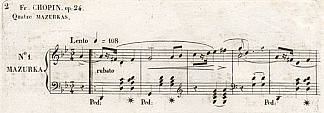When I was a kid I read a lot of books about musical performers, books filled with fantastic tales, of adventures on tour, of transcendental virtuosity — in the pre-recording era. This stuff can fire a teenager’s imagination. After reading about Arthur Rubinstein learning Franck’s Symphonic Variations on a long train ride (he went from the station to the first rehearsal), and Josef Hofmann performing a short piece after only hearing another pianist play it twice, I took action.
Along with several of my teacher’s students, I was scheduled to perform in a Sunday afternoon concert. I’d be playing Chopin’s Mazurka in B-flat Minor, opus 24, no. 4. On Saturday, the day before the performance, after finding out that my contribution to the concert could be lengthened, I learned the three other mazurkas  that make up Chopin’s Opus 24 — no. 1, in G Minor, no. 2, in C Major, and no. 3, in A-flat Major. I had read through the Lydian-inflected no. 2 before. No. 1 and no. 3 were unknown to me.
that make up Chopin’s Opus 24 — no. 1, in G Minor, no. 2, in C Major, and no. 3, in A-flat Major. I had read through the Lydian-inflected no. 2 before. No. 1 and no. 3 were unknown to me.
I started playing through these fairly short pieces and working on the trickiest spots. Almost right away, I attempted to play passages at tempo and without looking at the score. By the end of the day, I could play all the music through from memory. And I played through all four mazurkas for my parents.
About the concert, I don’t recall much. It went well. I didn’t say much about what I had done until much later on. It probably did have something to do with what I told Diane Zola when she came to my door in New York many years later.
She told me that a pianist was cancelling a performance and asked if I knew Gershwin’s Rhapsody in Blue. I told her I’d played it a few times (about 6 years earlier). The possible concert would be for an audience of several thousand, with New York’s Orchestra of St. Luke’s. “Can you perform the piece tomorrow night?” she asked. Perhaps with the mazurkas in the back of my mind, I told her, “Yes I can.”

In Heinrich Neuhaus’ wonderful “The Art of the Piano” (one of the very few books about piano-playing which deserves careful study and re-study) he recalls in detail setting himself the task, as a teenager, of learning and memorizing Beethoven’s “Hammerklavier” sonata in one week.
[Neuhaus was mentor to Richter and Gilels among others…]
He succeeded. But what I especially love about his recounting of the tale is the disclaimer at the end: of course, this demanded his full attention, there was no time for anything else.
Indeed!
Great story! And of course, there are 88 measures in the 1924 Rhapsody in Blue which are now available in publication. Your story reminds me of a few months ago when I received a Facebook message asking if I could play Tschaikowsky Concerto #1 the next week on short notice. Well, a week was not so bad, but I was away without the score, which I had not played in ten years (everyone asks for everything else!). I said, “Yes, I can” too. And I went to the hotel piano and, within two hours, it all started coming right back and was ready to go later that day. Not so sure I could have done that with Brahms 2 or Prokofiev 2, however. Fortunately, the Tschaikowsky concerto fits in the hands nicely and is easier to retain over the years.